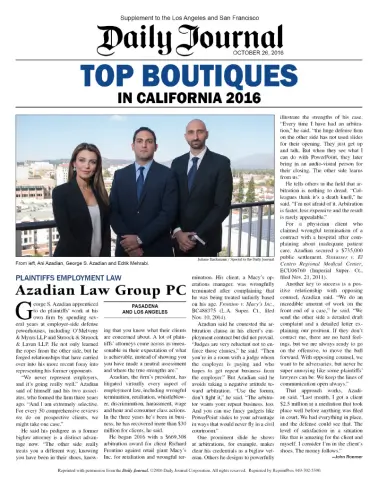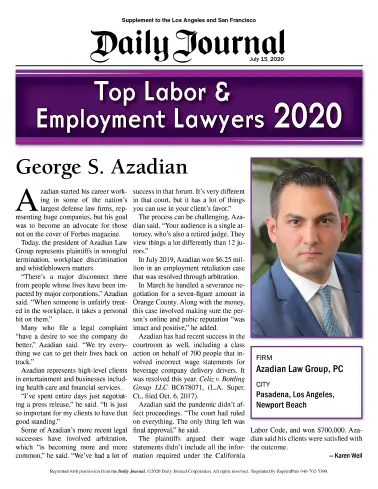How to Prove Discrimination at Work in California
It’s an unfortunate reality that many people working in California face discriminatory treatment from their employers. Some are denied employment for discriminatory reasons, while others endure hostile work environments and unfair treatment from their employers due to their status as members of protected classes. Unfortunately, it’s also common for employees to face discrimination without realizing it, believing the mistreatment they have experienced to be rooted in some other cause.
Ultimately, discrimination happens in many ways, and employers who knowingly engage in discriminatory workplace practices will typically leverage every possible excuse they can find to justify their actions. However, there is almost always some type of evidence that an employee can secure that proves the true intentions behind the mistreatment they have suffered. If you are unsure how to prove discrimination at work in California, review the following information and consult an experienced employment attorney as soon as possible.

What Is Discrimination?
Workplace discrimination occurs whenever an employer makes job-related decisions based on an employee’s protected personal qualities. Both federal and state laws prohibit any form of discrimination based on:
- Race, ethnicity, or national origin.
- Religion, creed, or spiritual beliefs.
- Age, medical status, and genetic information.
- Disability or perceived disabilities.
- Sex, gender expression, and sexual orientation.
- Pregnancy.
Discrimination takes many forms, from biased hiring decisions to discriminatory firings, promotion decisions, transfers, and delegation of job responsibilities. Employers are legally obligated to make their work-related decisions based on merit, performance, and seniority within the organization. However, employers who engage in discriminatory acts against employees will often use various justifications to mask their true intentions.
How Can I Prove Discrimination?
Consider an example of wrongful termination for discrimination. An employer holds a racial bias against an employee, and the employee makes a minor error that other employees have also made without severe reprimand in the past. As a result, the employer fires the employee, citing at-will employment law as their justification. In this example, the employee would have grounds for a wrongful termination claim against their employer based on racial discrimination, but they must prove the employer’s motivation.
This can seem complicated, but in this example, the employee could secure testimony from coworkers who had made similar errors and did not lose their jobs. Furthermore, if the fired employee is of a different race from these other employees, this would be strong circumstantial evidence showing the employer was biased and motivated by discrimination in their choice to fire the employee.
Ultimately, proving discrimination is the most challenging aspect of most discrimination claims. An employee adversely affected by discrimination in their workplace may need to secure copies of their email correspondence with their employer and obtain statements from coworkers detailing their experiences with the employer. Some coworkers may have overheard the employer mention their true motivation behind a recent action against an employee, which can be enough to legitimize a discrimination claim.
Can I Sue for Workplace Discrimination in California?
If you were adversely affected by an employer’s discriminatory acts, you likely have grounds for legal action against the employer. However, you cannot proceed directly with a civil suit against the employer after experiencing discrimination. First, you must file a complaint with the Equal Employment Opportunity Commission (EEOC), the government agency responsible for investigating workplace discrimination and harassment claims in the US.
Once the EEOC receives your claim, it will begin investigating it to determine if you have grounds for legal action. If the EEOC requires additional evidence or documentation, it will contact you and eventually deliver the findings of their investigation. If it determines your employer was discriminatory, it will likely issue you a Notice of Right to Sue that allows you to proceed with a lawsuit against your employer. In rare cases, typically those involving extreme examples of workplace discrimination, the EEOC may initiate legal proceedings on behalf of an affected employee.
FAQs
Q: What Is Considered Discrimination in the Workplace in California?
A: Discrimination in the workplace defines any situation in which an employer bases a work-related decision on an employee’s protected personal qualities or status as a protected class member. Discrimination takes many forms but typically pertains to hiring, firing, promotion, demotion, and disciplinary action in the workplace. Discrimination may be overt, such as directly firing an employee for a discriminatory reason, or it may be covert, and the employer may attempt to hide their motivations in various ways.
Q: What Is Required to Prove Discrimination in the Workplace?
A: If you wish to pursue a discrimination claim, you must first prove that you are a protected class member and have met your employer’s basic job expectations. Next, you must show that you suffered some adverse treatment in your workplace and that other similarly situated employees who are not members of your protected class did not experience the same treatment. Proving discrimination often requires establishing clear differences in an employer’s treatment of different employees.
Q: What Counts as Evidence of Discrimination?
A: The best form of evidence you can use in a discrimination case is a direct statement from the employer in question proving discriminatory intent. Some employers may make direct and offensive statements based on a particular race, sexual identity, or other protected personal qualities that an employee can later reference to substantiate their discrimination claim. Records of correspondence between the employee and their employer and testimony from coworkers can also be valuable evidence in some discrimination cases.
Q: How Hard Is It to Prove Employment Discrimination?
A: Success with discrimination cases can be difficult due to the challenge of securing viable evidence. Most employers who knowingly engage in discriminatory behaviors are wise enough to disguise their motivations as much as possible. For example, an employer may fire an employee on a discriminatory basis and attempt to use at-will employment law as a shield. If you are unsure what kind of evidence you need to prove employment discrimination, you should speak with an employment lawyer as soon as possible.
Facing discrimination in your workplace can be an isolating and distressing experience. You may feel hopeless when proving the nature of your recent experiences and holding your employer accountable. However, the Azadian Law Group, PC, has extensive experience handling complex workplace discrimination cases on behalf of our clients throughout California, and we can leverage this experience on your behalf. Contact us today to schedule a case evaluation and learn more about the legal services we offer.
Related Blog Posts
In the last 48 hours, Los Angeles has found itself at the center of a storm—again. Following a series of...
Read MoreIn a case drawing national attention, the Phoenix Suns have found themselves at the center of a legal storm. Former...
Read MoreAccess to restroom breaks is a fundamental workplace right, but what happens when an employer allegedly punishes an employee for...
Read MoreTypes of Cases Handle By Employment Lawyers in Los Angeles, CA
The following presents an overview of the broad range of employment law cases that our employment attorneys are experienced at overseeing and favorably resolving.
Wrongful Termination
Wrongful Termination Lawyers in Los Angeles, CA Attorneys at Azadian Law Group who have filed wrongful termination lawsuits acknowledge that unfair termination can significantly impact an employee’s life. It can…
Age Discrimination
Age Discrimination Lawyers in Los Angeles, CA Azadian Law Group, PC regularly represents clients throughout Los Angeles, CA, who are the victims of age discrimination in the workplace. At Azadian…
Pregnancy Discrimination
Pregnancy Discrimination Lawyer in Los Angeles, CA At Azadian Law Group, PC, our pregnancy discrimination lawyer in Los Angeles, regularly represents clients who are the victims of pregnancy discrimination in…
Sexual Harassment
Sexual Harassment Attorney in Los Angeles, CA The Los Angeles Sexual Harassment Lawyers at Azadian Law Group, PC, know that in today’s modern era, some people often make the mistake of…
Racial Discrimination
Racial Discrimination Lawyers in Los Angeles, CA Azadian Law Group, PC regularly represents clients throughout Los Angeles who are the victims of racial discrimination at work. The Los Angeles Race…
Disability Discrimination
Disability Discrimination Attorneys in Los Angeles, CA There is a misconception that disabled people do not want to work or that disabled individuals simply cannot or will not be as…
Praise from Our Clients
Who We Represent
At Azadian Law Group, we are dedicated to upholding the rights and interests of employees in the workplace. Our expertise in employment law positions us as staunch advocates for those facing unjust treatment in their professional environments.
Whether combating workplace discrimination, addressing unfair termination, or negotiating equitable compensation, our team is committed to ensuring that every employee we represent is treated fairly and respectfully under the law.

Step 1
Explore our comprehensive range of legal services to find the specialized support you need.
Step 2
Arrange a free initial meeting with our experts to discuss your legal situation.
Step 3
Receive a custom strategy specially created for your case by our legal experts.
Call Us Now 213-229-9031
Tell Us Your Story
Speak out for justice. Your story can be the start of a new chapter of workplace fairness.




